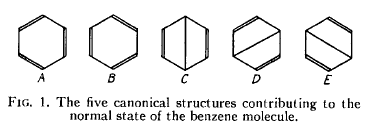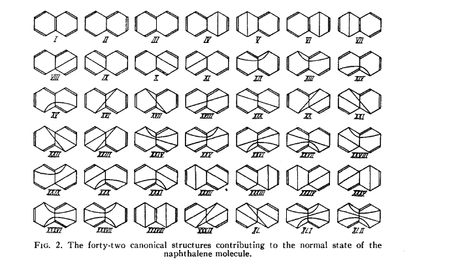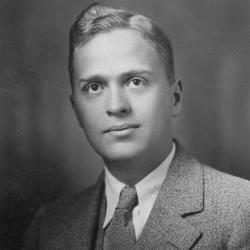
[What follows is Part 5 of 7 in this series. It is also the 800th blog post published by the Pauling Blog.]
“The Nature of the Chemical Bond. V. The Quantum-Mechanical Calculation of the Resonance Energy of Benzene and Naphthalene and the Hydrocarbon Free Radicals.” The Journal of Chemical Physics, June 1933.
With his fifth paper in the nature of the chemical bond series, Linus Pauling communicated a new understanding of the structures of benzene and naphthalene. While it had been long accepted that benzene (C6H6) was arranged as a six-carbon ring and naphthalene (C10H8) as two six-carbon rings, the specific organization of electrons and bonds within these structures were not known. Before the publication of Pauling’s fifth paper, several ideas on these matters had been proposed, but all were viewed as flawed in some way or another. But where others had been stymied, Pauling found success, and he did so by fully embracing and utilizing the theory of resonance.

At the time that Pauling began this work, there were five competing structures for benzene, each burdened by its own problems. The one that was the most accepted, despite its inability to connect theory to experimental data, was the Kekulé model. Put forth several decades earlier by the German chemist August Kekulé, this model centered around a six-carbon ring that possessed alternating double bonds. Because the arrangement of these double bonds could differ, Kekulé’s model was actually proposing two potential isomers for benzene. The standard understanding at the time was that these two isomers constantly oscillated between one another.
One major problem with the Kekulé approach was that scientists of his generation had never found evidence of the oscillating structures. Furthermore, the Kekulé structures should have been quite unstable, which was contrary to what researchers were able to observe in the laboratory. As such, even though it was compelling in the abstract, the Kekulé model was known to be imperfect.
In his paper, Pauling pointed out the flaws in Kekulé’s work as well as four other concepts published by other researchers. In doing so, he suggested that a common hindrance to all of the approaches was a reliance upon the laws of classical organic chemistry, and a concomitant lack of application of the new quantum mechanics. It was Pauling’s belief that the structure of benzene could be explained using quantum mechanics, as could the structures of all aromatic compounds.
In a handful of previous papers, Pauling had used the theory of resonance to explain a variety of chemical phenomena, but in thinking about benzene and naphthalene he committed more fully to its principles. According to Pauling, all observable data that had been collected for benzene, particularly its bond energies, suggested that benzene was much stronger than any models had yet to predict. But none of the previous models had entertained the possibility of a resonate structure, by which he meant an aggregate structure that was essentially a blend of all possible structures. A structure of this sort, Pauling argued, would conform to a lower, more stable energy state, and would accurately map with the observed data.
For Pauling, therefore, the structure of benzene was not the result of rapid isomerization as put forth by Kekulé, but rather a blend of states. “In a sense,” he wrote, “it may be said that all structures based on a plane hexagonal arrangement of the atoms – Kekulé, Dewar, Claus, etc. – play a part” but “it is the resonance among these structures which imparts to the molecules its peculiar aromatic properties.”
To support his theory, Pauling considered all five possible structures of benzene – which he called “canonical forms” – calculating the energy of each structure as well as the combined resonance energy. Having done so, Pauling then noted that it was the resonance energy that most closely matched the observed data.

In addition to its utility, the elegance of Pauling’s approach compared favorably with similar work being published by a contemporary, the German chemist Erich Hückel. Situating this thinking within Molecular Orbital theory, Hückel was able to arrive at a similar conclusion for benzene, but his calculations were quite cumbersome and could not be applied to larger aromatic compounds. By contrast, Pauling was now firmly rooted in Valence Bond theory and his formulae could be applied to all aromatics, not just benzene. In particular, by simplifying some of the calculations that Hückel had made, Pauling was able to overcome some of the mathematical hurdles posed by the free radicals in benzene and other aromatics.
To demonstrate the broad applicability of his ideas, Pauling applied his theoretical framework to naphthalene, which consists of two six-carbon rings and had forty-two canonical structures — a great many more than benzene’s five. Despite this significant difference, Pauling was successful in applying the same basic math to determine that the structure was also in resonance.
Indeed, Pauling was certain that his calculations were relevant to all aromatic compounds, noting specifically that “this treatment could be applied to anthracene [a three-ringed carbon molecule] and phenanthrene [a four-ringed carbon molecule], with 429 linearly independent structures, and to still larger condensed systems, though not without considerable labor.” Were one willing to expend this labor, the calculations would show that the “resonance energy and the number of benzene rings in the molecule would be substantiated” and the structure correctly predicted.

The fifth paper was unique in part because it was the first in the series to be co-authored. The article also marked a switch in publishing forum: whereas the first four had appeared in The Journal of the American Chemical Society, this paper (and the two more still to come) was published in volume 1 of The Journal of Chemical Physics.
Pauling’s co-author for the paper was George W. Wheland, a recent doctoral graduate from Harvard who worked with Pauling from 1932-1936 with the support of a National Research Fellowship. This collaboration proved noteworthy both for the quality of the work that was produced and also because Wheland later became a vocal supporter, advocate and contributor to resonance theory.
